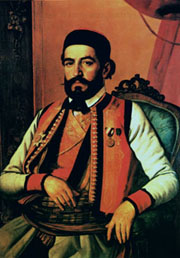A Most Memorable Memorial: Mount Lovcen, Montenegro

How would you like to be remembered? Please check one:
- Loving friend/spouse
- Corporate titan
- National hero immortalized as a giant marble statue, protected by a large eagle, on top of your nation’s biggest mountain
If you checked #3, prepare to be jealous. Find inspiration at Njegos’ tomb at Mount Lovcen in Montenegro.
Mount Lovcen is Montenegro’s largest mountain and, in a way, the namesake of the country. Montenegro (aka Crna Gore) means black mountain, and Mt. Lovcen is the tallest mountain in a country known for its high rocky terrain. At the summit of one of Mt. Lovcen’s peaks lies the tomb of Petar II Petrović-Njegoš, the former Montenegrin ruler who I thought was the name behind the ham I wrote about on Friday.
The Njegoš memorial may be one of the most popular sights in Montenegro, but that doesn’t mean it’s easy to reach. The road up the mountain is happily referred to as death valley—a one-lane (to be fair, sometimes one and a half lane) winding road with small guardrails and big scenery.
We breathed a sigh of relief once we reached the parking area, but the trek was far from over. A series of steps—461 to be precise—led through a tunnel and to the memorial statue.
 The chapel is the creation of Croatian sculptor Ivan Meštrović, who supposedly worked for a fee of Njeguški cheese and ham. (It’s that good, people.)
The chapel is flanked by two caryatids that must be over 20 feet high. Caryatids are statutes that function as columns. Am I a font of useless information, or what?
The chapel is the creation of Croatian sculptor Ivan Meštrović, who supposedly worked for a fee of Njeguški cheese and ham. (It’s that good, people.)
The chapel is flanked by two caryatids that must be over 20 feet high. Caryatids are statutes that function as columns. Am I a font of useless information, or what?
 The main sculpture, a 28-ton representation of Njegoš in the arms of an eagle, was made from a single block of granite. The archway above it is covered with 200,000 gold-plated tiles. Subtle it ain’t.
The main sculpture, a 28-ton representation of Njegoš in the arms of an eagle, was made from a single block of granite. The archway above it is covered with 200,000 gold-plated tiles. Subtle it ain’t.
 Behind the statue is the tomb of Njegoš, a simple but dramatically lit sarcophagus.*
Behind the statue is the tomb of Njegoš, a simple but dramatically lit sarcophagus.*
As dramatic as the chapel is, it can’t compare to the lookout point behind the tomb showing a panoramic view of Montenegro and, on a clear day, Italy.
 It’s one of the most impressive memorials I’ve seen, but it’s also one of the most controversial. It seems that Njegos didn’t want such a large, flashy tomb. He built his own chapel (left) on the top of Mt Lovcen in 1845, but it was destroyed in WWI. The current chapel was commissioned under protest by Yugoslav figures and the Serbian Orthodox church. It may not be how Njegos wanted to be remembered–but the crowds seem to disagree.
It’s one of the most impressive memorials I’ve seen, but it’s also one of the most controversial. It seems that Njegos didn’t want such a large, flashy tomb. He built his own chapel (left) on the top of Mt Lovcen in 1845, but it was destroyed in WWI. The current chapel was commissioned under protest by Yugoslav figures and the Serbian Orthodox church. It may not be how Njegos wanted to be remembered–but the crowds seem to disagree.
*I’ve wanted to legitimately use this word since high school, sorry.
Njegos Prsut: When a ham by any name is NOT the same
In the Balkans, people take their poetry and prosciutto seriously. So when we learned that there was a Montenegro prsut (prosciutto) named after a poet, we knew it had to be good.
We were right.
Njegoš prsut is named after Petar II Petrović-Njegoš. (Try to say that three times, fast.) Njegoš wrote famous epic poems, including The Mountain Wreath. For non-Balkanites, he’s what Shakespeare is to England. The Mountain Wreath is Balkan’s Hamlet. If I polled 10 Serbians on the street, I’d bet at least 7 of them could recite lines from his poems.
He wasn’t merely a poet, however. He was born into local royalty during the Ottoman hold over Montenegro. Eventually, he was made Bishop and helped form the various clans in Montenegro into a unified state. He’s seen as a benevolent king and has more likes on his Facebook page than I do. (Though so do most people…)
Best of all, he’s the namesake behind the smoked, dried ham pictured above. It’s sliced thin-to-medium thickness and doesn’t taste overly salty. The smoke flavor is there, but barely. It didn’t melt in our mouth but it did offer a delicate texture and hearty flavor. The secret is supposedly the grazing lands in Montenegro, though I’d imagine that many butchers have a special technique or two during the aging process. Whatever the secret is, it’s safe with Montenegrins, who assured (taunted?) us that we couldn’t get this kind of prsut anywhere else. Oh well. Njegos’ words may roll off the toungue, but his prsut rolls right on in.
UPDATE: a kind reader told me the following: It’s not named after (Petar II Petrović) Njegoš, it’s named after a village Njeguši (after which is Njegoš dynasty named too), nearby Cetinje, Montenegro. Njeguški pršut, not Njegošev pršut.
Darn it.I thought our waiter told us that it was named after the King, not the King’s hometown. I’m keeping the post though since I have more to say about Njegos tomorrow. As always, thanks for clarifying!










